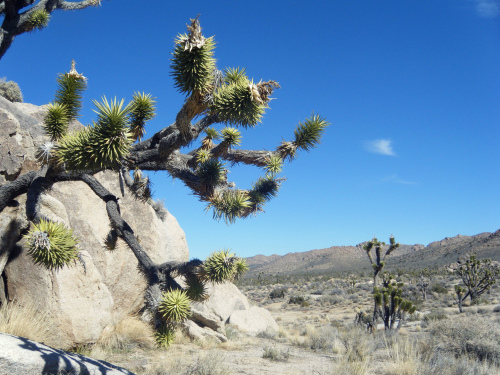Every Friday, Los Angelenos make a mass exodus to Las Vegas, traveling through the desert on an easy 400-kilometer drive up Interstate 15. Come Sunday, the caravan reverses, and they head home from a weekend at the casinos.
If you’re visiting Las Vegas, why not follow their lead and include a road trip to Los Angeles in your vacation? Better yet, spend a day or more on the drive and explore the landscape in between.
Although much of the California desert is sparsely populated, it’s loaded with otherworldly vistas and points of interest. You can see mountains splashed with a rainbow of reds, pinks, oranges, purples and greens. Spiky Joshua trees stand in splendor. If you’re lucky and visit in spring after a wet winter ― such as this one ― the desert floor might be covered with a blanket of wildflowers.
At Calico, California an abandoned silver-mining town is now a county park, and in Barstow, California, a once-derelict railroad depot has found new life.
I recently flew into Las Vegas and home from Los Angeles, taking the long way during the drive between the two cities.
If you’re visiting Las Vegas, why not follow their lead and include a road trip to Los Angeles in your vacation? Better yet, spend a day or more on the drive and explore the landscape in between.
Although much of the California desert is sparsely populated, it’s loaded with otherworldly vistas and points of interest. You can see mountains splashed with a rainbow of reds, pinks, oranges, purples and greens. Spiky Joshua trees stand in splendor. If you’re lucky and visit in spring after a wet winter ― such as this one ― the desert floor might be covered with a blanket of wildflowers.
At Calico, California an abandoned silver-mining town is now a county park, and in Barstow, California, a once-derelict railroad depot has found new life.
I recently flew into Las Vegas and home from Los Angeles, taking the long way during the drive between the two cities.

Our first stops were in the Mojave National Preserve, which covers 1.6 million acres. We were there for several hours yet saw only a small portion of the park.
We left Interstate 15 at Cima Road, two bumpy lanes that wind through the desert. We stopped to explore rock formations, then headed to the Kelso Depot Visitor Center, which was built in 1924 as a railroad stop. It contains a small museum, a restaurant and an information counter loaded with brochures. A ranger was on duty to answer questions.
In the distance we could see the Kelso sand dunes, which are almost 700 feet high and cover 45 square miles. Hikers can walk a 3-mile trail, and visitors are invited to run down the dunes, creating what the National Park Service describes as a “singing” or “booming” sound.
From Kelso, we headed north on Kelbaker Road to the town of Baker, passing the strange sight of red-and-black cinder cones and dark lava beds.
In addition to the paved roads, the preserve is crisscrossed with trails for off-road vehicles. Horses are welcome but not available for rental. (As the Park Service says, it’s “BYOH.”) Tours are conducted through the Mitchell Caverns. Two campgrounds are on the preserve, and roadside camping is permitted in some areas. The landscape is ancient, although the lava flows date to as little as 10,000 years ago.
For a look at the much more recent past, we headed to Calico Ghost Town, which is about 15 miles northeast of Barstow.
Calico was a silver-mining town in the 1880s, complete with shacks, saloons, hardship and revelry. Its mines produced $86 million in silver and $45 million in borax, but when the price of silver fell, the town was abandoned. By 1904 it was empty.
In 1951, Walter Knott (of Knott’s Berry Farm fame) restored the town and turned it into a tourist attraction. He donated it to San Bernardino County in 1966. About a third of Calico is original, and the rest is reconstructed. Visitors can tour a mine, take a train ride and explore a variety of shops, restaurants and historical displays.
A look at the mountains surrounding the town makes the source of its name obvious: The blotches of colorful rock resemble the multicolored calico cloth so popular when the West was young.
Admission to Calico Ghost Town is $6, and a campground is nearby.
Our next stop was history of an even more recent vintage. The Barstow Harvey House, “Casa Del Desierto” (House of the Desert) was built in 1911 on the Atchison, Topeka and Santa Fe rail line. It was a luxurious stop deep in the desert, offering hotel rooms and food. The Harvey House closed in 1971, long past its heyday. By the late 1980s, the building was badly deteriorated, coated with bird droppings inside and out. Looters and vandals had hauled away everything of value, but the beauty of the Spanish-Moorish structure still shone through.
After years of debate about the building’s future, its owner announced plans to tear it down. That spurred preservation efforts to pull together grants and other funding. The Harvey House was reopened in 1999. Today it is an Amtrak station and houses the local Chamber of Commerce, the Mother Road Route 66 Museum and the Western America Railroad Museum.
The traveler who wants to continue a trip through time might conclude with a tour of the Goldstone Deep Space Communications Complex for a look at the massive antennas that allow NASA to stay in touch with spacecraft venturing billions of miles away. Goldstone is located on Fort Irwin, the Army’s National Training Center, about 35 miles from Barstow. Reservations to visit must be made in advance.
By Judith Evans
(St. Louis Post-Dispatch)
(McClatchy-Tribune Information Services)


















![[Today’s K-pop] BTS pop-up event to come to Seoul](http://res.heraldm.com/phpwas/restmb_idxmake.php?idx=642&simg=/content/image/2024/04/17/20240417050734_0.jpg&u=)